A Foreigner’s Guide to Congolese Weddings
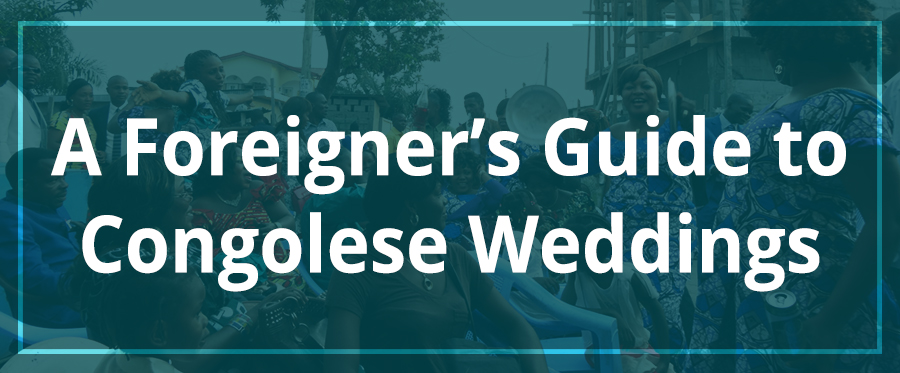
If you come from North America or Europe, chances are your expectation of a wedding is generally as follows: a ceremony in a church or at the courthouse and voila you’re married!
Things are… a little bit different in the Republic of Congo. Marriage season apparently comes in waves, and both in August and December it seemed like the tidal wave hit Brazzaville, or maybe it was just the people I happened to know. Either way, for roughly four weeks straight, I was at a wedding every weekend (three in one day once on my birthday – but that’s another story). Weddings here aren’t just a one and done sort of deal. Rather, prepare yourself for a three for one extravaganza! So here you have it: the foreigner’s guide to Congolese Weddings.
Getting Engaged: Le Premier Vin
Just a few weeks ago one of our interns in the office was officially engaged. While there may or may not be a ring involved, the process here goes a little like this: the boy and the girl like each other and decide they want to go for it. The boy, with his family representing him, will send word to the girl’s family that they are coming at a certain date and time. The family arrives, but the boy is not allowed to speak. It is in fact the boy’s father or uncle doing all the talking with the respective girl’s family representatives. The boy’s family brings drinks and a gift of money at this initial ceremony. The family discusses the engagement and now the girl is now officially allowed to go and stay at his house if she wants. This is often called the premier vin, literally, the first wine, referring to the drinks provided to each family. In the past this literally involved bringing jugs of palm wine for the engagement discussion, though today that could be sodas or other drinks. Sometime there is also a second ceremony of presentation to the other side of the family. This may actual be as far as the couple gets on the wedding process for a while, both families have accepted the couple is together, and saving up their money for the other steps.
Wedding Take 1: The Dot
Pronounced “dote” this is the traditional wedding ceremony. While it varies depending on if you’re from the north or south of Congo (and thus what tribe your parents are originally from), the general gist is that this is the party! The party, and most importantly, the presentation of gifts from the bridegroom to the bride’s family. This is also the reason why many couples in Congo don’t get officially married for years, if ever. At most weddings I’ve attended, the couple already has multiple children. Dots are expensive. After a man has announced his intention to marry the woman, her father, uncle and mother get together and come up with a long extravagant list of things the husband-to-be must bring their family. This can be everything from goats and chickens to expensive suits, pots, machetes, and lanterns.
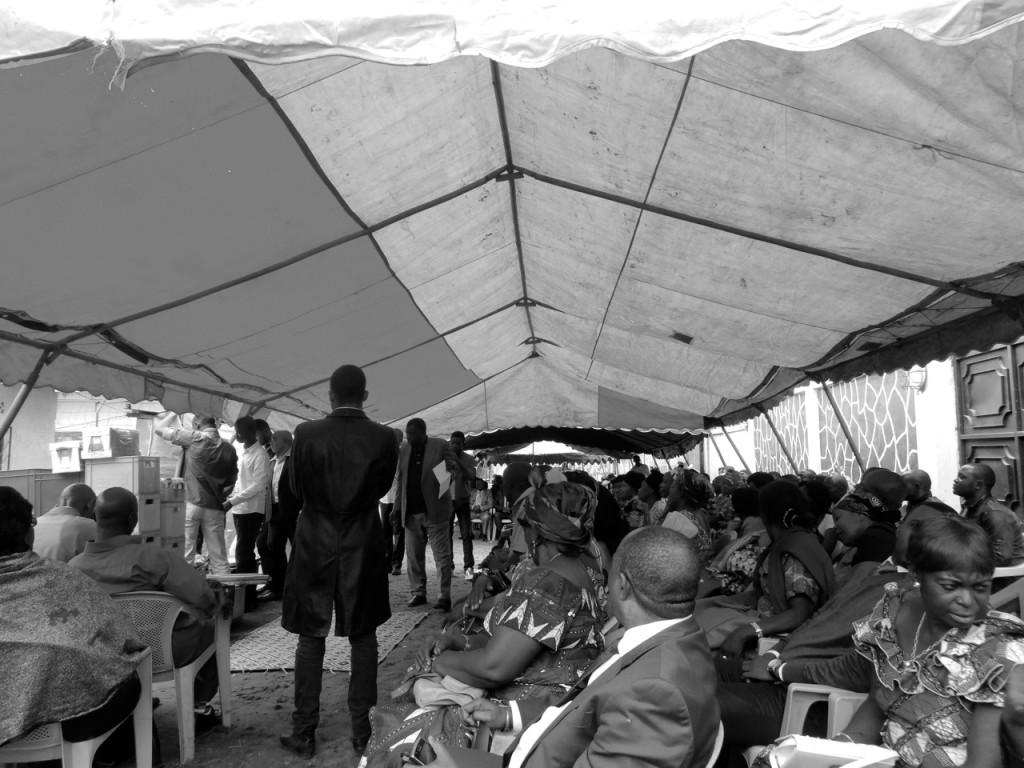
The ceremony generally takes place outside the father of the bride’s home. The family of the bride and the family of the groom sit in separate seating areas of chairs where large canopies have been set up to protect the crowd from the sun. As a blatant outsider, I just sit wherever I’m told and appear when somebody wants me to take a picture, or wants to take a picture with the resident moundélé. Each side of the family has what is essentially their own MC – and their selection of this person can often make or break the party atmosphere. Sometimes it ends up playing like a comedy act with each MC going back and forth trying to get the crowd excited, laughing and singing as they go through the rituals and present all of the gifts. One by one all of the items are brought out and shown to the bride’s family to have their quality inspected. This is no small feat and takes at least an hour.
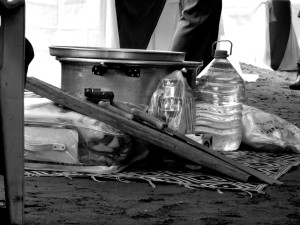
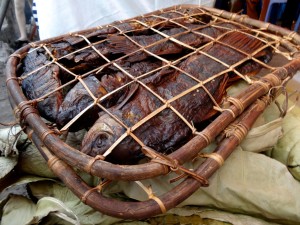

Once this is accomplished, the search for the mysteriously absent couple commences. This varies depending on the families, in my favorite wedding they found the groom inside the crowd somewhere and he then had to search for his bride. This family clearly had a sense of humor and brought out a woman with a huge veil covering her face- upon lifting it the groom discovered it was his bride’s cousin! Everyone burst out laughing and chanted at him to choose well. Sometimes the bride comes first and has to find her husband, once with the crowd singing in Lingala, “Make sure he’s handsome! Make sure he’s kind!” When the couple is found, they are taken to a couch where some speeches are made and they then have to give each other a drink (like the American tradition of feeding each other a piece of cake).
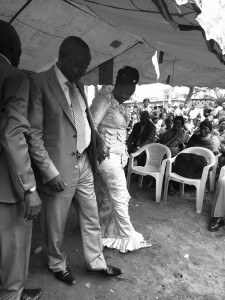
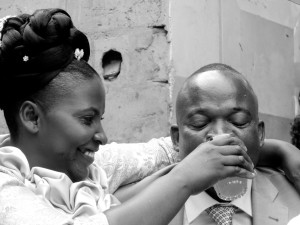
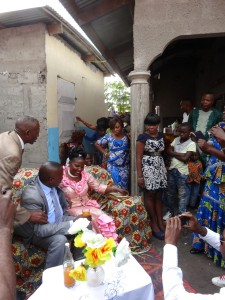
There is then the presentation of gifts from guests and family members, often pagne (traditional Congolese fabric) or household items, and then the party really begins. There is no party in Congo without food and drink. Suddenly crates full of glass bottles appear out of nowhere and soda, beer and wine is passed around. Large buffet tables are set up and you help yourself to a feast of fish, chicken, saka-saka, rice, manioc and friend plantains. Nobody goes hungry, even the random passersby who stop in. It’s a fun festive atmosphere and now everyone becomes much more festive with a little food in their stomach after what may have been a three hour service. Congratulations, you have completed step one.
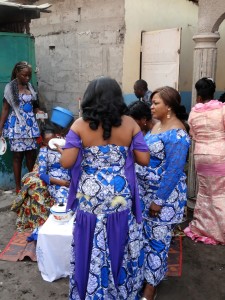
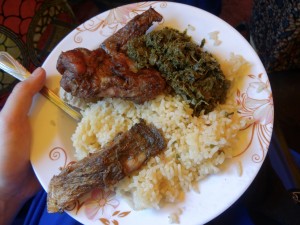
Wedding Take 2: The Civil Ceremony
The dot is a big deal, but it doesn’t stop there. While the dot does involve a great deal of giving and taking, it does not give you the right to wear a wedding ring. In order for that to happen, one must be officially married before the state, so now it’s time to go down to city hall! This wedding ceremony almost always takes place on a Saturday, and you can tell. On Saturday mornings, city hall is suddenly hopping with families and brides in elaborate poofy dresses and all of their female relatives in matching pagne. Gifts are once again given, this time by a small crowd of attendees, and the car to take the married couple away boasts a terrifying assortment of ribbons and soap-writing on windows. There is usually a reception after the civil ceremony, or if this happens in the morning, you might be able to fit in the third wedding that day: to the church!
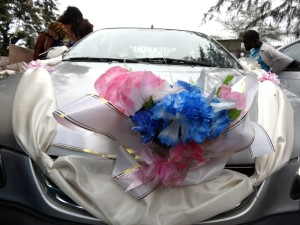
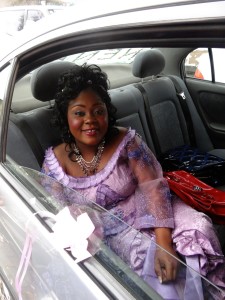
Wedding Take 3: Goin’ to the Chapel
You have now made it through stages one and two of a Congolese wedding and we have arrived at the final level. Brides change their poofy pink or pagne dresses for a white Western-style one. There is a sermon by the pastor and a great deal of singing before the bride and groom, who were seated on the stage, get up and exchange a few short vows. Once again, we bring on the presents- family and friends parade by their gifts, pictures are taken and the crowning element of the ceremony occurs: more food. There is a feast after every step, and that’s no small expense either. Food and photos are abundant as people selling minute-photos pop up out of nowhere to take your picture (be careful or you’ll find yourself being demanded to pay for a picture you didn’t know was taken). When the music and the food is over, the dancing can lead the couple out the door and into the once-more extravagantly decorated car to leave the ceremony, with people throwing confetti into the air and passing out candies in a bag of white netting.
After passing through all that, ceremony upon ceremony with food overflowing, high hairstyles, and the occasional goat making a bid at freedom, the couple has finally been officially married on every level. It is a long a difficult process, which means everyone definitely has a reason to celebrate the completion of each step! If you are ever in Congo, I recommend going to a dot at least once. It’s a small glance into a larger culture, and a great way to celebrate with friends.
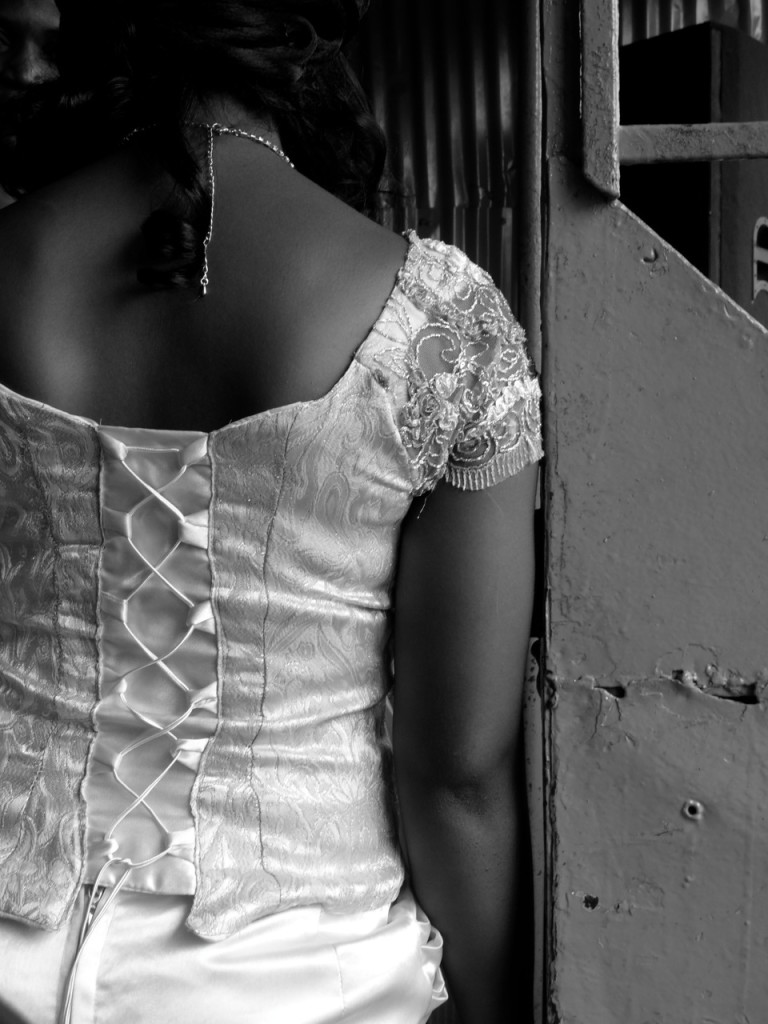
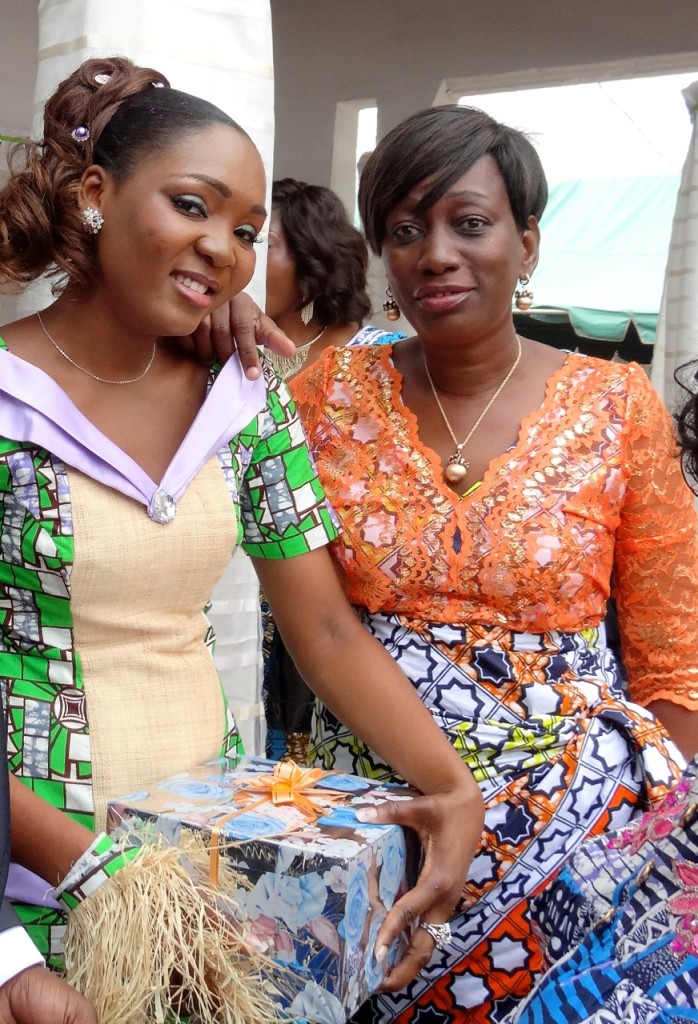
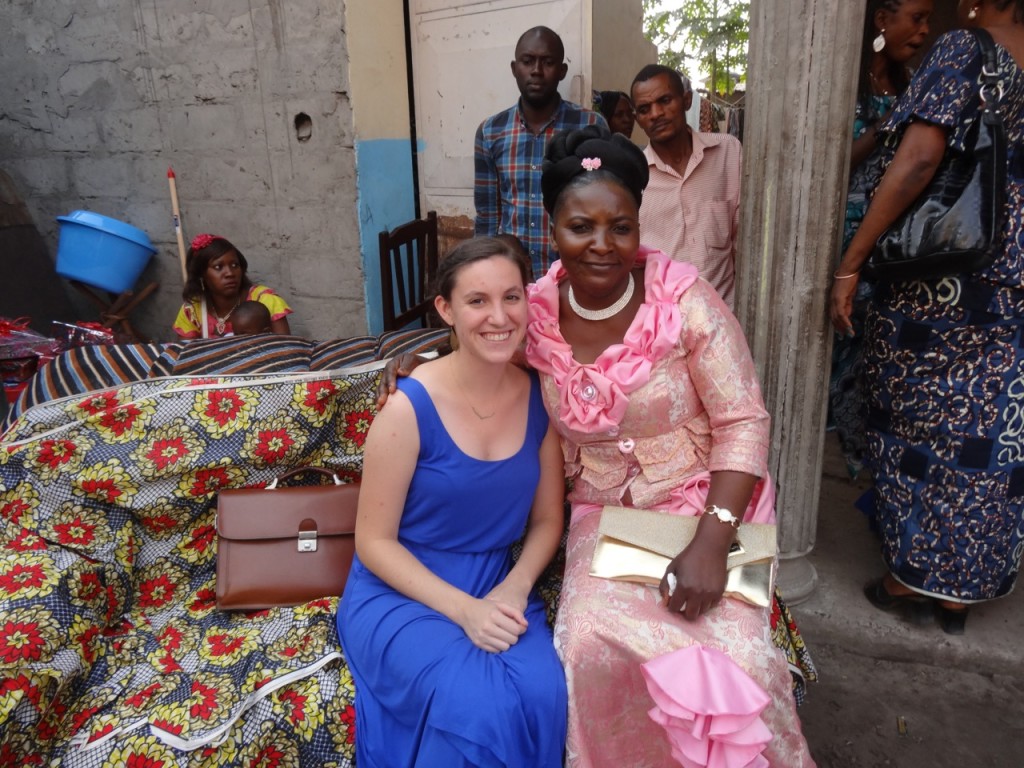
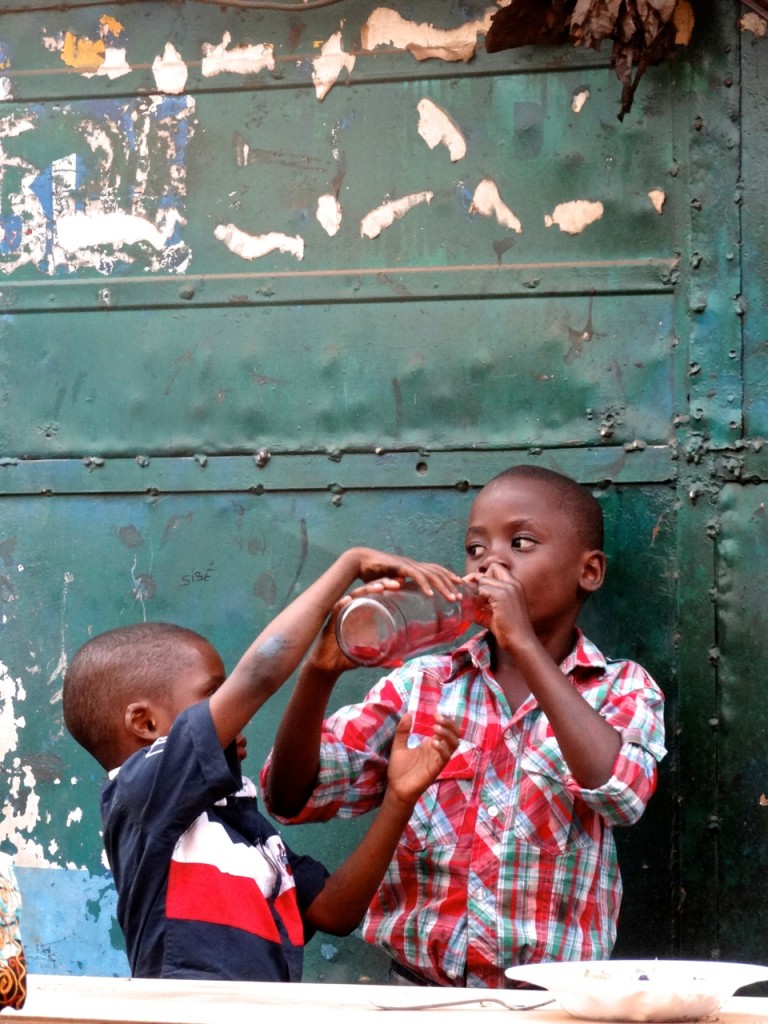
thank you for this article. My husband and I just did the civil wedding and I am trying to find ways to introduce him to the dot life without scaring him off already lol
Thank you so much for writing this. As a congolese girl(from Zaire) I have been having a hard time explaining the stages and steps of congolese weddings to my BF(white) and his family…this article just puts everything into perspective for me without having to go the extra mile and rambling when i talk about it.
Thank you so much!
So glad it helped you and your boyfriend!
This is really good. I am a teacher from Congo and we are doing a project about traditional weddings and this article really good and authentic.
Thank you
This article it very good to understand what the Congolese wedding like and good to Congolese people who left Congo so long time when they were little so they grow up in Europe so they don’t know any thing about Congolese wedding it great but it still hard for Congolese people who lives here in Europe to follow this 100% but its good article
Thanks
I’M PLANNING MY WEDDING TOO WITH MY BEAUTIFUL CONGOLESE FIANCEE, BUT I DON’T KNOW IF MY PARENTS ARE TO SEND A LETTER TO HER PARENTS AS MY FAMILY ARE ITALIANS AND THEY LIVE IN ITALY WHILE HER AND HER PARENTS LIVES IN ENGLAND. IS THE LETTER A FORM OF COMMUNICATION OR IT’S PART OF THE CONGOLESE TRADITION? BECAUSE IF IT’S A FORM OF COMMUNICATION I WAS THINKING THEY CAN JUST MAKE A NORMAL PHONE CALL SINCE WE ARE IN THE MODERN DAYS. OR VIDEO CALL ASWELL. PLEASE I NEED SOME HELP BECAUSE IT’S QUITE WORRYING.
Great article! As a Caucasian-Canadian who was invited to attend a wedding “party” and had no idea what to bring as a present, I came across your article which have me so much more insight into the wedding process. I attended the party after the dot and according to my Congolese colleague and friend, will also be invited to the second party, the civil ceremony and party.
Thank you again for the article! Still unsure what to give as a present though….
Good article thks . please is it the groom or the bride groom church that the wedding ceremony takes place thkni
Ok thanks for explaining so my understanding is that this is basically a combination of Three things African culture without no outside influence and the Other two as a result of colonialism which brings in Christianity and the Going to the civil court.
Thanks for the article. it really helped me understand the various stages. Am just getting started with the ‘dote’ stage since my fiancee is from the Congo but this article has given me a better idea of what to expect and how to go about it. thanks much